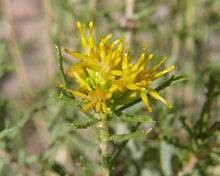Isocoma tenuisecta
| Burroweed | |
|---|---|
 | |
| Scientific classification | |
| Kingdom: | Plantae |
| Clade: | Angiosperms |
| Clade: | Eudicots |
| Clade: | Asterids |
| Order: | Asterales |
| Family: | Asteraceae |
| Genus: | Isocoma |
| Species: | I. tenuisecta |
| Binomial name | |
| Isocoma tenuisecta Greene 1906 | |
| Synonyms[1] | |
| |
Isocoma tenuisecta, commonly called burroweed, shrine jimmyweed, or burrow goldenweed is a North American species of small, flowering perennial herbs in the sunflower family. It is native to Arizona, New Mexico, and Sonora.[2][3]
Isocoma tenuisecta grows 1 to 3 feet (30–90 cm) tall. Leaves are narrowly lance-shaped, with numerous large teeth or small lobes along the edges. The leaves are glandular and lobed. The plant flowers in September through November, with clusters of heads at the ends of branches and on top of the main stem. Each head contains 8-15 yellow disc flowers but no ray flowers. The old heads turn dry and tan and remain on the plant after the achenes have dispersed.[4]
Burroweed is poisonous to mammals.[5]
Gallery
References
- ↑ The Plant List, Isocoma tenuisecta Greene
- ↑ Biota of North America Program 2014 county distribution map
- ↑ SEINet, Southwestern Biodiversity, Arizona chapter photos, description, distribution map
- ↑ Flora of North America, Isocoma tenuisecta Greene, 1906. Shrine jimmyweed , burroweed
- ↑ United States Food & Drug Administration, Poisonous Plants Database.
External links
This article is issued from
Wikipedia.
The text is licensed under Creative Commons - Attribution - Sharealike.
Additional terms may apply for the media files.

